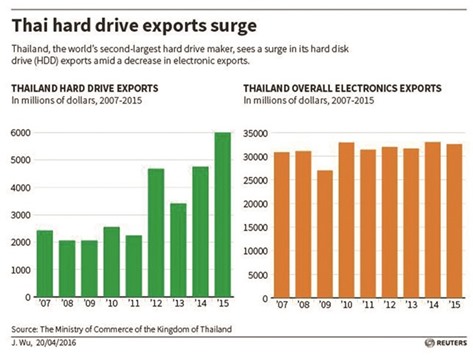Thailand is on course for economic growth of 3.1% in 2016 despite the lacklustre global economy and delays in state spending, so there is no need for a change in the country’s monetary policy, a senior central bank official said yesterday.
When the Bank of Thailand (BoT) cut its 2016 growth projection to 3.1% last month, it said the economy was losing steam as the impact of government stimulus faded. But that was not a signal a rate cut would come soon, deputy governor Paiboon Kittisrikangwan told Reuters.
He described the Thai economy as “trudging along”.
“Given the outlook that we see for the whole year, if nothing changes, if there are no major shocks or no major unexpected events, we don’t think any change in monetary policy stance is warranted,” he said.
The benchmark one-day repurchase rate has been left at 1.50% since April 2015.
The central bank next reviews monetary policy on May 11, and most economists expect no change.
In the first quarter, annual growth likely was around 3%, Paiboon said. The government will report official January-March growth in May.
Slower demand from major trade partners such as China is a downside risk to the 2016 growth forecast, he said. Around 10% of Thai exports go to China.
The BoT forecasts exports from the trade-dependent economy will fall 2% in 2016, the fourth consecutive annual contraction. Exports are worth more than 60% of Thailand’s GDP.
A surprise rise in first quarter customs-cleared exports reported on Monday was largely due to exceptional items, he said. Strip them out, and exports would show a small decline on the year, he added. State spending on a raft of infrastructure projects worth over $50bn that should boost long-term productivity has been “slower than we might have hoped,” he said.
Record household debt levels remain a concern, he said.
Major Thai commercial banks have cut their lending rates this month, and that should aid struggling consumers and small firms he added.
The move was a surprise, given it was a year since the central bank had cut rates and lower interest margins will dent bank profits.
Paiboon declined to say if the central bank put pressure on the commercial banks to cut, but said “moral suasion” with the banks it oversees is one of the BoT’s monetary tools.
Other factors contributed to the banks’ decisions, he said. Large capital inflows had led to a sharp drop in bond yields, and banks were flooded with liquidity, he said.
Consumer prices should begin to rise again in the third quarter, he said. Headline inflation has contracted 15 straight months through March.
But consumers were not delaying purchases in the hope of cheaper future prices, so the BOT saw no danger of a deflationary spiral, he added.

..

